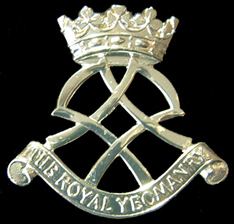Active 1 April 1967– Branch British Army Role Light Cavalry | Allegiance United Kingdom Type Yeomanry Size One Regiment | |
 | ||
The Royal Yeomanry (RY) is the senior reserve light cavalry regiment of the Army Reserve. The Regimental Headquarters is located at Fulham in London, with Squadrons spread amongst London and the Midlands at Nottingham, Dudley, Croydon, Windsor, Telford & Leicester. The regiment is part of the Royal Armoured Corps and is paired with the 1st The Queen's Dragoon Guards.
Contents
History
The Royal Yeomanry was formed in 1967, following the amalgamation of six distinguished county yeomanry regiments, as a medium reconnaissance regiment equipped with armoured cars. It continued in this role until 1996, when it became the British Army's NBC defence regiment. It served exclusively in this role until 1999, when the Joint NBC Regiment was formed.
Two of the Royal Yeomanry's squadrons (A and W) were retained in the NBC role to provide reserves for front line NBC troops. The remaining three converted to Challenger 2 to serve as reserves for armoured regiments. In January 2003, A and W Squadrons were mobilised for Operation TELIC, the war in Iraq. The two squadrons were amalgamated with a number of augmentees from the other three squadrons and from the Royal Logistic Corps to form a much-enlarged "Y" Squadron of the Joint NBC Regiment. This was the first deployment of a formed TA unit (TA soldiers under TA command) for combat operations since the Suez crisis in 1956. During the war, officers and soldiers of the Royal Yeomanry found themselves serving with 16 Air Assault Brigade, 7 Armoured Brigade (the Desert Rats) and 3 Commando Brigade as NBC specialists, before switching roles to infantry peace support operations once Saddam Hussein’s regime had collapsed.
The Royal Yeomanry has maintained a constant presence in Iraq since March 2003. The regiment's soldiers have been mobilised for each of the subsequent TELICs. Since 2007, the Royal Yeomanry has provided upwards of 500+ officers and soldiers as individual replacements on Operation HERRICK in Afghanistan.
Future
Under Army 2020, it is proposed that the Royal Yeomanry will lose two squadrons (D and E). The Royal Yeomanry will be paired with 1st The Queen's Dragoon Guards and be under the command of 7th Infantry Brigade. The regiment's main equipment will be the Land Rover RWMIK reconnaissance vehicle.
Organisation
The regiment consisted of six squadrons and a military band: In July 2014 'A (Royal Wiltshire Yeomanry) Squadron (Swindon)' transferred to the Royal Wessex Yeomanry, and two Squadrons transferred in from the Royal Mercian and Lancastrian Yeomanry, leaving the following:
The Royal Yeomanry's role is light cavalry: providing a rapidly deployable force with fast mobility and substantial firepower as part of the British Army's combat arm. Its soldiers provide reconnaissance, reassurance, security and, if the situation demands it, decisive tactical effects by raiding and attacking the enemy.
Battle honours
As a result of the Regiment's initial service during the Iraq war, in 2005 the Royal Yeomanry was awarded the theatre honour "Iraq 2003", the first battle honour the regiment has won since its formation, and the first – so far the only – battle honour awarded to an Army Reserve regiment since the Second World War.
The squadrons forming the Royal Yeomanry also hold hundreds of battle honours won by their predecessors.
Order of precedence
For the purposes of parading, the Regiments of the British Army are listed according to an order of precedence. This is the order in which the various corps of the army parade, from right to left, with the unit at the extreme right being the most senior.
